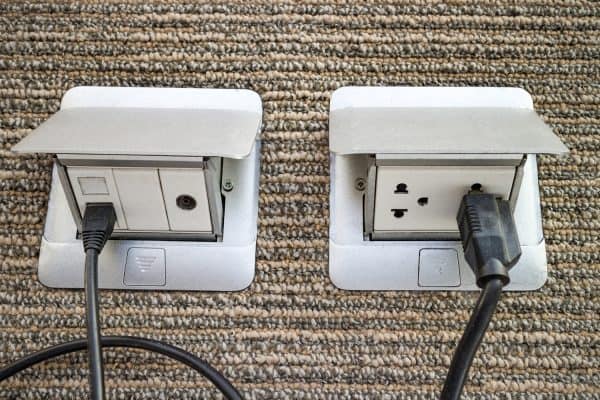An ottoman is a popular and useful furniture item to have in your living room. Along with serving as a footrest, an ottoman can provide extra seating, extra table space, and possibly extra storage. Ottomans come in endless designs, so you may be wondering: does my ottoman need to match my sofa? We've done the research and have all the answers to help you choose the perfect ottoman.
You should coordinate the ottoman with your sofa, but it does not need to match exactly. Here are the best options for pairing your ottoman with your sofa:
- Mix solid colors with patterns
- Mix and match solid colors
- Pair bold colors with monochromes
Keep reading for examples of ottomans matched with sofas, where to place your ottoman, and how to choose the right height and fabric for your ottoman. We'll also show you how to reupholster an ottoman to get the exact look you want!
![A yellow sofa matched with sky blue ottoman, Should Ottoman Match Sofa? [Inc. 3 Coordination Tips]](https://homedecorbliss.com/wp-content/uploads/2020/09/Should-Ottoman-Match-Sofa-Inc.-3-Coordination-Tips-683x1024.jpg)
Mix Solid Colors With Patterns
Compatible Pallettes
This patterned ottoman adds personality and interest to an otherwise simple beige sofa. The color palette of the ottoman is compatible with the couch, and adding a few throw pillows in the same fabric helps tie the whole room together.
Match Colors
This gray and white geometric-patterned ottoman would look amazing paired with a dark gray sofa like this one. Notice that while the legs are not identical, they are a similar color and style, which helps coordinate the ottoman with the couch. As a bonus, this ottoman has a hidden storage space inside.
We may include affiliate links and curated AI content to highlight top design styles.
Click for this patterned storage ottoman on Amazon.
Click for this dark gray sofa on Amazon.
Mix Colors
You don't have to stick to the same color when choosing a patterned ottoman to match with your sofa. This colorful European-inspired ottoman pouf would also look great as an accent to that dark gray sofa above. As long as the colors in your couch and ottoman don't clash, feel free to have fun and choose whatever fits your style.
Click for this colorful ottoman pouf on Amazon.
Bright with White
Here's another fun option for dressing up a plain sofa. If your couch is cream or white, you can match it with pretty much any color or pattern you like to bring your style and personality to your living room.
Go Bold in Small Spaces
The blue tones in this festive floral ottoman coordinate well with the blue couch. Choosing a bold pattern for a small ottoman like this is a great option when you want to provide an interesting accent piece that doesn't overwhelm the entire space.
Light and Dark
The blue in this lovely patterned ottoman matches well with the sofa while the white background in the ottoman fabric provides a nice balance to the darker couch.
Mix and Match Solid Colors
Contrasting Colors
If you have a light couch, choosing a darker color for your ottoman offers a lovely contrast.
Matching Tones
But having two dark colors together can also work. Here the blue and green are a similar tone, and choosing the same velvety fabric for both the couch and ottoman makes them a perfect match.
Adjust the Shades
You can mix and match while still maintaining a neutral look. White, black, or gray would all work with this gray couch. The same concept applies if your sofa is tan, blue, red, or any other color: choose an ottoman in the same tone but a shade darker or lighter than your couch, and you can't go wrong.
An Exact Match
The easiest way to make sure your ottoman coordinates with your sofa is to buy a matched set. This pretty blue sectional is one example, but you are sure to find a sofa set that fits your taste if you prefer another color or style.
Click for this blue sectional on Amazon.
Details Matter
With this stylish black sofa set, not only the color and fabric match but also the nailhead detailing. Make sure to consider these extra elements when choosing your sofa and ottoman.
Click for this black sofa set on Amazon.
This ottoman would work well as a colorful accent to the sofa set above since it includes similar nailhead detailing.
Click for this ottoman with nailhead detailing on Amazon.
Pair Bold Colors With Monochromes
Brighten Up
If you have a monochrome couch, choose a bold color for your ottoman and then finish the look with coordinating throw pillows.
Add Some Color
Even a small ottoman can add a happy burst of color to your neutral couch.
Click for this tufted storage ottoman on Amazon.
Pick Your Favorite
If you have a light gray couch, you can pair it with bright purple, bold red, or whatever color you love best.
Click for this light gray couch on Amazon.
Click for this square ottoman on Amazon.
Where Do You Put An Ottoman In The Living Room?
One of the most convenient spots to place your ottoman is right in front of your couch. Here, it can serve double duty as a coffee table with the addition of a simple tray on top. When you want to put your feet up, slide the tray out of the way.
Click for this 7-piece sectional with ottoman on Amazon.
If you have a smaller ottoman, you can place it next to your coffee table where it can serve as additional seating.
You can even place an ottoman or two under your coffee table for a clean, decluttered look.
An ottoman doesn't have to be the center of the room. Consider tucking it over to one side for use as an end table.
Here's another option for keeping your ottoman handy, but out of the way. Tuck it under a console table, either behind your couch or against the wall.
Can Ottoman Be Taller Than Couch?
Your ottoman should not be taller than your couch. Since an ottoman is primarily used as a footrest, you want to make sure it's at a comfortable height. If your ottoman is taller than your couch, it would feel awkward when propping your legs on it and could lead to back or knee pain.
Ideally, your ottoman would be the same height as your couch, but if you can't find an exact height match or it's more comfortable for your legs and back, you can choose an ottoman that's an inch or so shorter than your couch instead.
What Is The Best Fabric For An Ottoman?
When choosing fabric for your ottoman, you want something durable, stain-resistant, easy to clean, and that will not wrinkle or fade. Higher thread counts generally mean better quality and durability. You may want to avoid high-maintenance fabrics like linen and silk that will require professional cleaning, especially if your ottoman is located in a high-use area like your family room.
Recommended Fabrics:
- Cotton and cotton blends
- Microfiber
- Leather
- Vinyl (lower cost option to leather, but durability varies)
- Wool and wool blends
- Acrylic
- Olefin
- Blends that include nylon or rayon
How To Reupholster An Ottoman?
Check out this ">video for a step-by-step guide on how to reupholster an ottoman. No sewing is required!
Materials Needed:
- Foam
- Batting
- Upholstery fabric
- Dust cover fabric
Tools Needed:
- Drill or screwdriver
- Scissors
- Needle-nose pliers
- Staple gun
- Hot glue gun
Step 1: Strip the Old Ottoman.
- Remove the legs using a drill or screwdriver. Repaint if you want, or keep them as is.
- Remove any old fabric, foam, batting, and loose staples. (Note: if the foam is still in good shape, you can reuse it.)
Step 2: Position the New Upholstery Materials.
- Place foam atop ottoman and cut to fit as needed.
- Place batting over foam and trim to fit. (Check out the video for how to cut corners to prevent bunching.)
- Position fabric over batting. Make sure any pattern or design in the material is aligned how you want it, then flip the ottoman over, taking care to keep the fabric in place.
Step 3: Staple Both Sides.
- Starting in the center of one side, staple the fabric to the bottom of the frame using a staple gun. Place the staples about half an inch apart and keep the material taut as you go, making sure it does not bunch.
- After you finish one side, staple the opposite side next. Again start in the center and check that the fabric stays smooth.
Step 4: Staple and Fold the Corners.
- Staple along the top edge, starting from the center. Stop about an inch from the corner.
- Fold in the corner like you would a present, creating a smooth seam. See the video for how this should look.
- Trim away any excess fabric to prevent bunching, and then staple the corner in place.
- Continue the same process on the other top corner, and then for the bottom edge and corners.
- After you have stapled all the sides, trim away any excess fabric about a half-inch from the staples.
Step 5: Attach the Dust Cover Cloth.
- Place dust cover fabric over the bottom and trim to fit.
- Fold in the edge of the cloth to create a neat edge and then staple in place along one side, starting in the center. Place staples about two inches apart.
- Continue on the opposite side and then the top and bottom edges. Leave the corners for last and fold them in neatly before stapling in place.
Step 6: Finish the Ottoman.
- Use a hot glue gun to secure the fabric along each corner seam.
- Reattach the legs using a drill or screwdriver.
- Enjoy your refreshed ottoman!
Summary
As you can see, the options are pretty much endless for pairing an ottoman with your sofa. If you're ready to choose the perfect ottoman, check out our top 40 online stores for buying an ottoman. And once you find an ottoman you love, you'll want to consult our handy guide on how to keep it clean.












